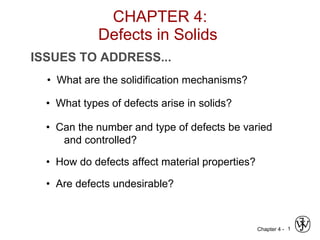
Material Science Chapter 4
- 1. CHAPTER 4: Defects in Solids ISSUES TO ADDRESS... • What types of defects arise in solids? • Can the number and type of defects be varied and controlled? • How do defects affect material properties? • Are defects undesirable? • What are the solidification mechanisms?
- 6. Types of Imperfections • Vacancy atoms • Interstitial atoms • Substitutional atoms Point defects • Dislocations Line defects • Grain Boundaries Area defects
- 7. Point Defects • Vacancies : -vacant atomic sites in a structure. • Self-Interstitials : -"extra" atoms positioned between atomic sites. Vacancy distortion of planes self- interstitial distortion of planes
- 8. Equilibrium Concentration: Point Defects Boltzmann's constant (1.38 x 10 -23 J/atom-K) (8.62 x 10 -5 eV/atom-K) N v N exp Q v k T No. of defects No. of potential defect sites. Activation energy Temperature Each lattice site is a potential vacancy site • Equilibrium concentration varies with temperature!
- 9. Measuring Activation Energy • We can get Q v from an experiment. N v N = exp Q v k T • Measure this... N v N T exponential dependence! defect concentration • Replot it... 1/ T N N v ln - Q v / k slope
- 10. Estimating Vacancy Concentration • Find the equil. # of vacancies in 1 m 3 of Cu at 1000 C. • Given: A Cu = 63.5 g/mol = 8.4 g / cm 3 Q v = 0.9 eV/atom N A = 6.02 x 10 23 atoms/mol For 1 m 3 , N = N A A Cu x x 1 m 3 = 8.0 x 10 28 sites 8.62 x 10 -5 eV/atom-K 0.9 eV/atom 1273K N v N exp Q v k T = 2.7 x 10 -4 • Answer: N v = (2.7 x 10 -4 )(8.0 x 10 28 ) sites = 2.2 x 10 25 vacancies
- 11. Observing Equilibrium Vacancy Conc. • Low energy electron microscope view of a (110) surface of NiAl. • Increasing T causes surface island of atoms to grow. • Why? The equil. vacancy conc. increases via atom motion from the crystal to the surface, where they join the island. Reprinted with permission from Nature (K.F. McCarty, J.A. Nobel, and N.C. Bartelt, "Vacancies in Solids and the Stability of Surface Morphology", Nature, Vol. 412, pp. 622-625 (2001). Image is 5.75 m by 5.75 m.) Copyright (2001) Macmillan Publishers, Ltd. I sland grows/shrinks to maintain equil. vancancy conc. in the bulk.
- 12. Point Defects in Alloys Two outcomes if impurity (B) added to host (A): • Solid solution of B in A (i.e., random dist. of point defects) • Solid solution of B in A plus particles of a new phase (usually for a larger amount of B) OR Substitutional solid soln. (e.g., Cu in Ni ) Interstitial solid soln. (e.g., C in Fe ) Second phase particle --different composition --often different structure.
- 16. Line Defects • are line defects, • slip between crystal planes result when dislocations move, • produce permanent (plastic) deformation. Dislocations : Schematic of Zinc (HCP): • before deformation • after tensile elongation slip steps Adapted from Fig. 7.8, Callister 7e.
- 19. Motion of Edge Dislocation • Dislocation motion requires the successive bumping of a half plane of atoms (from left to right here). • Bonds across the slipping planes are broken and remade in succession. Atomic view of edge dislocation motion from left to right as a crystal is sheared. (Courtesy P.M. Anderson)
- 21. Edge, Screw, and Mixed Dislocations Adapted from Fig. 4.5, Callister 7e. Edge Screw Mixed
- 23. Dislocations & Crystal Structures • Structure: close-packed planes & directions are preferred. view onto two close-packed planes. close-packed plane (bottom) close-packed plane (top) close-packed directions • Comparison among crystal structures: FCC: many close-packed planes/directions; HCP: only one plane, 3 directions; BCC: none • Specimens that were tensile tested. Mg (HCP) Al (FCC) tensile direction
- 26. Optical Microscopy • Useful up to 2000X magnification. • Polishing removes surface features (e.g., scratches) • Etching changes reflectance, depending on crystal orientation. Micrograph of brass (a Cu-Zn alloy) Adapted from Fig. 4.13(b) and (c), Callister 7e. (Fig. 4.13(c) is courtesy of J.E. Burke, General Electric Co. crystallographic planes 0.75mm
- 27. Optical Microscopy Grain boundaries... • are imperfections, • are more susceptible to etching, • may be revealed as dark lines, • change in crystal orientation across boundary. Adapted from Fig. 4.14(a) and (b), Callister 7e. (Fig. 4.14(b) is courtesy of L.C. Smith and C. Brady, the National Bureau of Standards, Washington, DC [now the National Institute of Standards and Technology, Gaithersburg, MD].) ASTM grain size number N = 2 n -1 number of grains/in 2 at 100x magnification Fe-Cr alloy (b) grain boundary surface groove polished surface (a)
- 30. Scanning Tunneling Microscopy (STM) • Atoms can be arranged and imaged! Carbon monoxide molecules arranged on a platinum (111) surface. Photos produced from the work of C.P. Lutz, Zeppenfeld, and D.M. Eigler. Reprinted with permission from International Business Machines Corporation, copyright 1995. Iron atoms arranged on a copper (111) surface. These Kanji characters represent the word “atom”.
- 31. Summary • Point , Line , and Area defects exist in solids. • The number and type of defects can be varied and controlled (e.g., T controls vacancy conc.) • Defects affect material properties (e.g., grain boundaries control crystal slip). • Defects may be desirable or undesirable (e.g., dislocations may be good or bad, depending on whether plastic deformation is desirable or not.)
- 32. ANNOUNCEMENTS Core Problems: Self-help Problems: Reading:
Hinweis der Redaktion
- Optical microscopy good to ca. wavelength of light Higher frequencies X-rays – good idea but difficult to focus Electrons - wavelength proportional to velocity with high voltage (high acceleration) get wavelengths ca. 3pm (0.003nm) (x1,000,000)